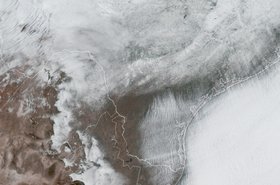The events earlier this year in Texas, as detailed extensively on our pages, gave further evidence, if it were needed, that operators must do their utmost to shield their operations from grid instability. And the opportunity to exercise greater control over energy expenditure through power decentralization is also gathering pace. The role of the microgrid in offering a resilient solution was among the insights from a presentation by Allan Schurr, CEO of Enchanted Rock, at the recent DCD>Grid Scale event, which is now available to watch ‘on-demand’ by clicking here or by filling in the form below.
A microgrid offers resiliency while at the same time optimizing investments in backup power, supporting grid stability and increased penetration of renewable energy assets. This session outlined the path to microgrid adoption and highlighted the role they might play in a carbon-free future for critical power.
As Schurr introduces, there are several aspects to be taken into consideration: “I believe that microgrids can provide an important bridge to the long term decarbonisation that is really driving the energy grid as well as some of the specific attributes for how microgrids compare to other technologies, both on an environmental and an economic standpoint.”
For Enchanted Rock, there are three major drivers of the changing grid.
First, there’s decarbonization. The influences here include more utility scale and on-site renewables, electrification of transportation (increasing demand), retirements and, emerging in the future, 24-hour grid storage.
And then comes emerging critical infrastructure, with organizations demand more power flexibility, protected circuits that reduce operator flexibility and an expectation of higher grid performance.
Finally, there is the anticipated increase in extreme weather events, with threats to facilities in the form of water and wind (from hurricanes, high winds, floods), fire and heat (leading to high demand, public safety power shutoff - PSPS - events and smoke reducing solar power efficiency), and ice and cold (causing high demand, impacts on plant performance and line icing).
Schurr gives further details into the changing pressures that weather is putting on industry: “2020 was a record year for 'named' hurricanes. We went well past the alphabet into the next series of names and the damage was substantial along the US Gulf Coast and elsewhere. There was a high wind event that went through the Iowa and Illinois market, and power outages that lasted over a week. The number of record rain storms and flooding has peaked in the last few years in the US; we also have a growing threat related to persistent wildfires in the West, along with record temperatures and the issues that brings.”
Watch this insightful presentation for further details on the opportunities around the microgrid and how, to quote Schurr, “consumers and businesses are taking into their own hands the need to protect themselves from an increasingly fragile grid…" Fill in form below to watch on-demand now.
More from DCD
-

Sponsored Going beyond compliance: When compliance alone is not enough
Data center diesel back-up hasn’t changed for more than 20 years, but there is a better way that should satisfy everyone
-

Sponsored The definitive account of February’s Texas power outage
EPRA’s Dan Smith and Foster Fuel’s Will Rohrig describe to DCD exactly what happened, and why
-

Broadcast DCD>Building at Scale | Stream on-demand
How can you continue to deliver on data center construction demand and meet the need for speed?
